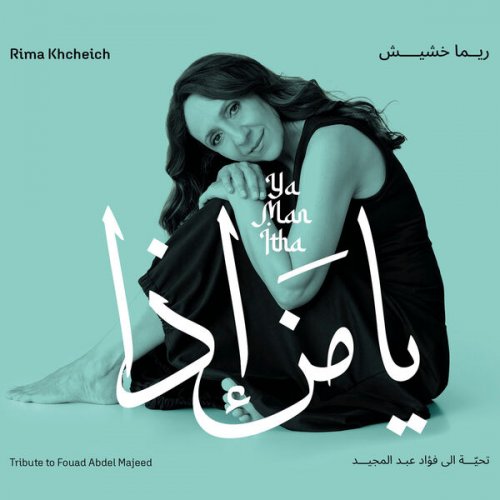Murray Perahia - Brahms: Handel Variations (2010)

Artist: Murray Perahia
Title: Brahms: Handel Variations
Year Of Release: 2010
Label: Sony Classical
Genre: Classical
Quality: FLAC (tracks)
Total Time: 01:18:16
Total Size: 257 Mb
WebSite: Album Preview
Tracklist: Title: Brahms: Handel Variations
Year Of Release: 2010
Label: Sony Classical
Genre: Classical
Quality: FLAC (tracks)
Total Time: 01:18:16
Total Size: 257 Mb
WebSite: Album Preview
Händel Variations, Op. 24
01. Händel Variations, Op. 24 - 00:25:59
Two Rhapsodies, Op. 79 (Johannes Brahms)
02. Rhapsodie in B Minor, Op. 79, No. 1 - 00:09:02
03. Rhapsodie in G Minor, Op. 79, No. 2 - 00:06:15
Six Piano Pieces, Op. 118 (Johannes Brahms)
04. Intermezzo in A Minor, Op. 118, No. 1 - 00:01:51
05. Intermezzo in A Major, Op. 118, No. 2 - 00:05:10
06. Ballade in G Minor, Op. 118, No. 3 - 00:03:30
07. Intermezzo in F Minor, Op. 118, No. 4 - 00:02:35
08. Romance in F Major, Op. 118, No. 5 - 00:03:55
09. Intermezzo in E-flat Minor, Op. 118, No. 6 - 00:05:10
Four Piano Pieces, Op. 119 (Johannes Brahms)
10. Intermezzo in B Minor, Op. 119, No. 1 - 00:03:36
11. Intermezzo in E Minor, Op. 119, No. 2 - 00:04:16
12. Intermezzo in C Major, Op. 119, No. 3 - 00:01:42
13. Rhapsodie in E-Flat Major, Op. 119, No. 4 - 00:05:22
Performers:
Murray Perahia (piano)
Sony’s accompanying press release states that “after a long and successful period devoted to J. S. Bach, Grammy-winning pianist Murray Perahia shifts his attention back to Brahms for the first time in 20 years.” True enough, but what the press release doesn’t say is that there’s not a lot to return to. As far as I can tell, Perahia never recorded much Brahms to begin with. I’m aware of only three CDs: the G-Minor Piano Quartet, op. 25, with the Amadeus Quartet in 1987; the two-piano version of the Haydn Variations with Georg Solti in 1988; and the Sonata No. 3 in 1991. The last-named disc also contained a number of Brahms’s shorter piano pieces, two of which are duplicated on the present release in newly recorded performances: the first of the two Rhapsodies, op. 79/1, and the last of the Six Piano Pieces, the Intermezzo, op. 118/6. Even adding the items on this new release to the tally, there is still much left undone. If shifting attention back to Brahms signals a commitment by Perahia and Sony to fill in the gaps, they have their work cut out for them and we have much to look forward to.
No one would question Perahia’s credentials as one of the keyboard greats of our time. His self-conducted cycle of Mozart’s piano concertos is a staple of the catalog, and his more recent immersion in Bach has produced a series of insightful performances that have contributed immeasurably to his legacy. One might say that Perahia’s mastery of Bach has positioned him well to grasp and grapple with the contrapuntal inclinations of Brahms, especially in what is arguably the composer’s greatest work for solo piano, the Variations on a Theme by Handel.
The Handel Variations has received much attention lately on CD. Within recent memory, I’ve reviewed new recordings by Cynthia Raim ( Fanfare 33:2), Andreas Boyde (33:5), Ragna Schirmer (34:3), and Sheila Arnold (not yet published as of this writing). All had their strong points, but it was Raim I kept coming back to for the most satisfying fusion of technical assurance and structural concentration. Thus, it was her version I settled on to compare to Perahia’s. Overall, Perahia is 1:43 faster than Raim, but such a comparison does not take into account that in the statement of the theme Raim sets a quicker pace than Perahia, and that in most of the variations the timings differ by only two or three seconds. The biggest single difference occurs in the concluding fugue, which Raim takes more expansively—5:14 to Perahia’s 4:53. Only in almost imperceptible increments—two seconds here, three seconds there—does the 1:43 difference accumulate.
One complaint I do have about the new recording, though the doing is Sony’s, not Perahia’s, is that the entire work has been banded into a single track. That made a variation-by-variation comparison very difficult. After careful and repeated listening, however, my conclusion is that Perahia’s reading is more linear than Raim’s, which is to say that he emphasizes the independence and interplay between voices in a way that reflects the contrapuntal discipline he has internalized from his study and playing of Bach. In a couple of ways, this is very desirable in that, one, it allows Brahms’s invention to emerge with great clarity, and two, it endows each variation with its own personality, which in Perahia’s hands can sometimes be quite fanciful. Yet, in another way, I find that this leads to a tendency to treat each variation as a separate entity that is not causally related to the whole. Raim’s approach to each variation is perhaps a bit less imaginatively or flamboyantly characterized, but her reading gains cumulative strength through revealing the connective tissue that binds the skeleton together. Truth be told, I think Perahia and Raim complement each other, and I’d find it hard to choose between them. Both, in their own way, offer much.
I believe it was G. B. Shaw who, before grudgingly admitting he’d been wrong about Brahms, was quite critical of the composer, criticizing in particular Brahms’s heavy reliance on pedals—not the foot levers on a piano, but the persistent and pervasive ostinato figures that occur with great regularity, a signature really, throughout his music. More often than not these take the form of triplets in one insistent pattern or another, and no better example of this exists than in the G-Minor Rhapsody, op. 79/2. The entire piece from beginning to end is nothing but triplets in constant flux between the right and left hands and between the melody and the accompanimental figuration. The same could be said of the first movement of Beethoven’s “Moonlight” Sonata, but Brahms’s rhythmic procedures are more sophisticated and complex, such that one is not always aware that every single measure is triplet based. Perahia is quite powerful and dramatic in the exposition and recapitulation sections, while in the central development section he’s mysterious and searching.
The B-Minor Rhapsody, op. 79/1, is also an agitated affair and as rhythmically complex as the G-Minor work, but not in the same obsessive way. There’s real Dionysian vs. Apollonian contrast between the two identifiable themes, one vehement and turbulent, the other pleading and sorrowful. Perahia is Mars one moment and Venus the next.
Between the two rhapsodies of 1879 and the final sets of piano pieces, there’s a hiatus in Brahms’s writing for solo piano, a period that saw completion of some of his most beloved works. Not until 1892 would Brahms turn one last time to the piano to write the four groupings of pieces that comprise opp. 116, 117, 118, and 119. Here we find ourselves in a sound world different from anything he’d composed for piano before, a world that, in some instances, can be harmonically vague and pre-Impressionistic, as in opp. 118/2 and 6, and 119/1, while in others—opp. 118/1 and 3, and op. 119/4—it can be a shaking of the fist at Fate recalled from the sturm und drang of the earlier rhapsodies, but now in foreshortened and compressed form. Perahia brings a touch of magic to these pieces, conjuring tonal tints and dynamic shadings that capture the evocative essence of each of them.
This is most strongly recommended, and with the hope that we not have to wait another 20 years before Perahia offers us more of his Brahms. -- Jerry Dubins
No one would question Perahia’s credentials as one of the keyboard greats of our time. His self-conducted cycle of Mozart’s piano concertos is a staple of the catalog, and his more recent immersion in Bach has produced a series of insightful performances that have contributed immeasurably to his legacy. One might say that Perahia’s mastery of Bach has positioned him well to grasp and grapple with the contrapuntal inclinations of Brahms, especially in what is arguably the composer’s greatest work for solo piano, the Variations on a Theme by Handel.
The Handel Variations has received much attention lately on CD. Within recent memory, I’ve reviewed new recordings by Cynthia Raim ( Fanfare 33:2), Andreas Boyde (33:5), Ragna Schirmer (34:3), and Sheila Arnold (not yet published as of this writing). All had their strong points, but it was Raim I kept coming back to for the most satisfying fusion of technical assurance and structural concentration. Thus, it was her version I settled on to compare to Perahia’s. Overall, Perahia is 1:43 faster than Raim, but such a comparison does not take into account that in the statement of the theme Raim sets a quicker pace than Perahia, and that in most of the variations the timings differ by only two or three seconds. The biggest single difference occurs in the concluding fugue, which Raim takes more expansively—5:14 to Perahia’s 4:53. Only in almost imperceptible increments—two seconds here, three seconds there—does the 1:43 difference accumulate.
One complaint I do have about the new recording, though the doing is Sony’s, not Perahia’s, is that the entire work has been banded into a single track. That made a variation-by-variation comparison very difficult. After careful and repeated listening, however, my conclusion is that Perahia’s reading is more linear than Raim’s, which is to say that he emphasizes the independence and interplay between voices in a way that reflects the contrapuntal discipline he has internalized from his study and playing of Bach. In a couple of ways, this is very desirable in that, one, it allows Brahms’s invention to emerge with great clarity, and two, it endows each variation with its own personality, which in Perahia’s hands can sometimes be quite fanciful. Yet, in another way, I find that this leads to a tendency to treat each variation as a separate entity that is not causally related to the whole. Raim’s approach to each variation is perhaps a bit less imaginatively or flamboyantly characterized, but her reading gains cumulative strength through revealing the connective tissue that binds the skeleton together. Truth be told, I think Perahia and Raim complement each other, and I’d find it hard to choose between them. Both, in their own way, offer much.
I believe it was G. B. Shaw who, before grudgingly admitting he’d been wrong about Brahms, was quite critical of the composer, criticizing in particular Brahms’s heavy reliance on pedals—not the foot levers on a piano, but the persistent and pervasive ostinato figures that occur with great regularity, a signature really, throughout his music. More often than not these take the form of triplets in one insistent pattern or another, and no better example of this exists than in the G-Minor Rhapsody, op. 79/2. The entire piece from beginning to end is nothing but triplets in constant flux between the right and left hands and between the melody and the accompanimental figuration. The same could be said of the first movement of Beethoven’s “Moonlight” Sonata, but Brahms’s rhythmic procedures are more sophisticated and complex, such that one is not always aware that every single measure is triplet based. Perahia is quite powerful and dramatic in the exposition and recapitulation sections, while in the central development section he’s mysterious and searching.
The B-Minor Rhapsody, op. 79/1, is also an agitated affair and as rhythmically complex as the G-Minor work, but not in the same obsessive way. There’s real Dionysian vs. Apollonian contrast between the two identifiable themes, one vehement and turbulent, the other pleading and sorrowful. Perahia is Mars one moment and Venus the next.
Between the two rhapsodies of 1879 and the final sets of piano pieces, there’s a hiatus in Brahms’s writing for solo piano, a period that saw completion of some of his most beloved works. Not until 1892 would Brahms turn one last time to the piano to write the four groupings of pieces that comprise opp. 116, 117, 118, and 119. Here we find ourselves in a sound world different from anything he’d composed for piano before, a world that, in some instances, can be harmonically vague and pre-Impressionistic, as in opp. 118/2 and 6, and 119/1, while in others—opp. 118/1 and 3, and op. 119/4—it can be a shaking of the fist at Fate recalled from the sturm und drang of the earlier rhapsodies, but now in foreshortened and compressed form. Perahia brings a touch of magic to these pieces, conjuring tonal tints and dynamic shadings that capture the evocative essence of each of them.
This is most strongly recommended, and with the hope that we not have to wait another 20 years before Perahia offers us more of his Brahms. -- Jerry Dubins

![Koralle, Yawuh - Primo Quarto (2025) [Hi-Res] Koralle, Yawuh - Primo Quarto (2025) [Hi-Res]](https://www.dibpic.com/uploads/posts/2025-10/1761554081_a0812196791_10.jpg)


![Miho Terachi - Beautiful Magic (2016) [Hi-Res] Miho Terachi - Beautiful Magic (2016) [Hi-Res]](https://www.dibpic.com/uploads/posts/2025-10/1761721171_fsgyh7gyiq3pa_600.jpg)

![Terumasa Hino - Beyond The Mirage (2019) [Hi-Res] Terumasa Hino - Beyond The Mirage (2019) [Hi-Res]](https://www.dibpic.com/uploads/posts/2025-10/1761645632_ng2s5vodz5wqa_600.jpg)
![Ben Paterson - Eleanor Rigby (Live at the Jazz Showcase, 2025) (2025) [Hi-Res] Ben Paterson - Eleanor Rigby (Live at the Jazz Showcase, 2025) (2025) [Hi-Res]](https://img.israbox.com/img/2025-10/29/tqxoqdpm7e0ahq2rkr1gqj9la.jpg)
![Agustin Pereyra Lucena - Ese Dia Va A Llegar (2025) [Hi-Res] Agustin Pereyra Lucena - Ese Dia Va A Llegar (2025) [Hi-Res]](https://www.dibpic.com/uploads/posts/2025-10/1761819427_a3280339657_10.jpg)